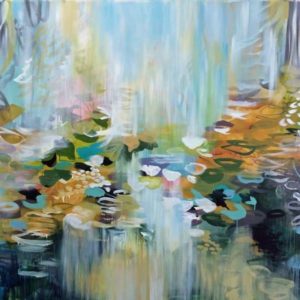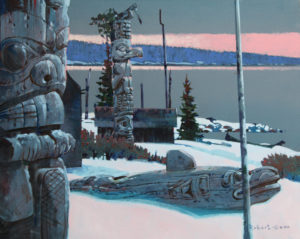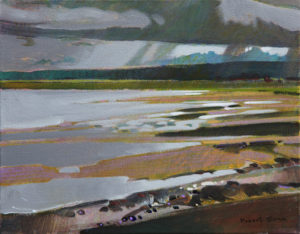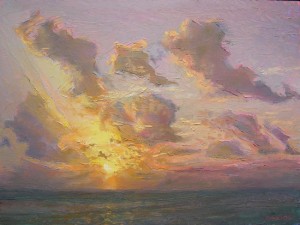Dear Artist,
A subscriber wrote, “I have recently been given an assignment by a mentor to paint, without restraint, 20 or so small abstract pieces that express the emotions of an illness I have been managing for years. I find myself stuck, stuck, choked with fear…emotion. I find myself not knowing how to visualize, begin to ‘show,’ express emotion. Usually it seems that feeling or emotion just shows up. To invite, command the same has me stuck. Does one just begin?”
Yes. Just begin. Without knowing the nature of your illness or how you’ve been managing, it’s been my experience that if you’re feeling frozen, it’s best to begin with a thaw. Suffering is a human experience that carries the potential to be one of art’s most powerful channels. Who are we, as artists, if not strivers to make the ineffable — our universal human truths — somehow visible so that others may see them too, and not feel alone? Instead of trying to identify and decipher feelings to paint, consider just painting, with no particular feelings in mind. Here’s an idea, I’ll call it, “M.E.L.T:”
M – Make paintings automatically: Allow the unconscious mind to take over, suppressing your reticular activating system — the network of neurons in your brain that, when aroused or stressed, including from pain or illness or when thinking about these things, trigger a “fight or flight” response. Your studio, instead of being a place of paralyzing fear or “flight,” can blossom into a comforting sanctuary. Once relaxed, the limbic system — your brain’s emotion and memory bank — can tap into its sympathetic nervous system mode: “rest and digest.” This “digesting” is the key to accessing the insight you’re looking for.
E – Exorcise/Exercise fear: Turning negative emotions into art can bring meaning to suffering. Just remember the emotions are what you’re using, not the suffering or illness causing the emotions. Emotions are powerful springboards because they’re dynamic, evolving and temporary. If artists are professional feelers, why not put our feelings, including fear, to work? “Feel the fear,” wrote ’80s self-help guru Susan Jeffers, “and do it anyway.”
L – Put love into it — love for yourself, for others, for your resilience and creativity. If you can respond to your circumstances with creative productivity and love yourself through difficulty, you have a vehicle for moving through experiences with tenderness, purpose and a connection to others.
T – Think, last. Contemplate your output after a period of subconscious activity. Look for pathways, like intuitively chosen colours, strokes, gestures and objects that point toward feelings. This is the opposite of trying to identify feelings first and then painting what you think they should look like. These paths can then guide you to a more illustrative representation of what’s inside, if that’s where you want to go.
Sincerely,
Sara
PS: “Where you stumble, there lies your treasure.” (Joseph Campbell)
Esoterica: During a rocky time in my own life — a time I can look back on now and describe as “suffering,” I turned to the creative instrument that had been with me the longest — my piano. Like twenty or so small abstracts, the sketches came out at first as tonal, mood pieces, then later fleshed into capsules I can revisit with tenderness and appreciation. I comforted myself with an aspiration to make the most beautiful thing I could muster. I wanted to break my own heart with its beauty, in the hope that it would, in turn, repair my broken heart. I am, perhaps, still trying. My dad called it, “paddling the great rivers,” and when he was given a terminal diagnosis, he painted until the last weeks of his life, when the meds made his hand too shaky and he began to dictate his letters to me, to send to you. He made his most dream-like, maybe even idealized, paintings of his life then. For him, these works were not literal representations of his intense, rushing, crushing emotions, but rather an expression of his spirit and values, now heightened and soaring.
“All the world is full of suffering. It is also full of overcoming.” (Helen Keller)
My album ‘Lifedrawing’ is available to stream or download on Amazon , Apple Music and Google Play.
 Have you considered a Premium Artist Listing? With each letter, an artist is featured at the bottom of this page. The Premium Artist Listings are a means of connecting artist subscribers through their work. Proceeds from each listing contributes to the production of The Painter’s Keys.
Have you considered a Premium Artist Listing? With each letter, an artist is featured at the bottom of this page. The Premium Artist Listings are a means of connecting artist subscribers through their work. Proceeds from each listing contributes to the production of The Painter’s Keys.
“Start where you are, use what you have, do what you can.” (Arthur Ashe)
Featured Workshop
A 3 day Non-Objective Painting Workshop with Cat Tesla and Julie Schumer
in Santa Fe, New Mexico
 Explore and develop your personal voice in the inspirational environment of Santa Fe. We will explore composition, color, value and how to work on multiples at the same time. Find your own signature with different mark making tools and learn how your marks enliven your paintings. Learn how to harmonize any palette, move from analysis paralysis to painting success and to trust your artistic choices. This intensive 3 day workshop is perfect for the beginning artist who has some experience using acrylic paint.
Explore and develop your personal voice in the inspirational environment of Santa Fe. We will explore composition, color, value and how to work on multiples at the same time. Find your own signature with different mark making tools and learn how your marks enliven your paintings. Learn how to harmonize any palette, move from analysis paralysis to painting success and to trust your artistic choices. This intensive 3 day workshop is perfect for the beginning artist who has some experience using acrylic paint.
August 14, 15, and 16
9 am to 4:30 pm
$950 Bring a friend and save $50 each
https://artbycat.com/page/1-Workshops-Prints.html
Featured Artist
Capturing the beauty of nature and expressing those impressions in oil paint is a joy. Every hour of the day presents new possibilities and keeps even the same landscape location, same composition, an ongoing and beckoning challenge. For this reason, I love painting series: it is exploration made visual.








37 Comments
Just fabulous. I do have trouble getting down to paint . I lost my wife after 50 years of marriage to a beautiful Angel. When l go to my studio sit down take a deep breath it seems that she is guiding my emotions and the process seems less emotional but angelic. Thank You so much Steven Wolk Canadian Artist. To all of you
Yes, excellent ideas to quiet your monkey mind and thaw the right side of your brain. Also, I start with words or scribble- pictures using my non dominant hand. That works of the time!
Thank you for this posting. It really connected with me.
missed this letter when it arrived, because I was at ER; now I will be missing some of my vision [at least for some months….] This Letter speaks to me, and all the commenters relating. As well, of course, it touches on the eternal problems charging our engines to paint. So appreciating the timing of your dad’s letter, and also connecting with those who are sharing their resulting insights. Just a really big Thank You for this one!!
Sorry about your vision, so hard for an artist. Working will exercise your eyes. Not knowing your specific issue, I will say there are vision exercises. Try to find a “behavioral optometrist” or an Occupational therapist who specializes in vision
So well put. Read with great interest how your own dad processed his own ending. Have looked forward to post for years now.
New email address, same old Susan
Thank you, Sara. For wisdom you share with us, we love Robert, we love you.
Yes, we painter have that itch in the soul to get to the universal self with form and color. It is HIDDEN somewhere behind the veil of the psyche.
With much love and respect. Nader
naderart.com
Your father’s wisdom, and art, will live in the memories of so many of us for a lifetime. He is sorely missed.
Having lost my focus and purpose for making art some years ago, I stumbled upon art journaling. Assembling packed little collages turned out to be an immensely satisfying, if not compulsive, self-expression. My sole guide to composition was: is it better with or without this… ? In that climate emotion is reached.
Subject to blinding headaches in the first 25 years of my life I learned to visualize them as a bright light. I allowed the dark to creep in around the edges until able to extinguish the light and the headache. To me illness is anger and the color red represents it. I would paint a large red shape centered and then paint the colors around it to reduce it, neutralize the red, until it was reduced in intensity to appearing to be a gray. A great exercise and it might get you started on 20. Hope it helps.
Beautifully put, Sara. I always look forward to these letters
I was diagnosed as having cancer at the same time as your Father and followed very closely. For me, it seemed like a miracle that he continued painting while having Chemo, I couldn’t seem to do that. I survived the Chemo and Radiation and have passed the 5-year mark. I am very lucky that the treatment worked. I live in a retirement home and I
do some painting. I have donated some of them as a fundraiser for the Alzheimers Society. Thank you for all the beautiful, helpful letters, Sara.
Sara, I’m a proponent of not intellectualizing my fine arts works. I really don’t care to tell story. What I care about is the aesthetic of the work — that’s what drives me. I’m going through issues with cancer and it’s treatment, but I don’t want to paint about it. Yes, how I feel emotionally may affect my process of creating the art, but it’s not my goal. If the painting comes off well, then I’m happy. If it’s so-so, I’ll try to improve it. If it’s bad, I’ll destroy it. So, if your dad said just get on and do it, he was right. It’s not really important that it reflects on your state of mind, it’s getting it done that counts. Thanks for your letter, Sara.
Thank you Sara for sharing one of your father’s final paintings from 2014. It would be very interesting to see more of them.
This letter was helpful, and so too the comments.
Find what you love in life, then love it until you can’t love any more.
Take advice to improve your skills, but never let another tell you, what your art should be.
That is something only you can decide.
Thanks for your letter. In 2015 I had emerg surgery and after 3 weeks of rest I needed to go into my studio to create art. What came out was very different from my regular practice and it definitely helped the healing process. Art is a Healer
Deeply moving …
I don’t know. If you are managing your illness why do you have to drag it all out for the world to see.
If you feel frozen just put a single colour down. If you feel like it add a dash of another. That is where you are now. Gradually you will probably feel like putting more colours and shapes down.Don’t over complicate it and expect to make “works of art” Don’t expect to say anything or have to explain. Your inner world always comes out in your art anyway, whether you want it to or not. That is what art is.
Absolutely precious, Sara. Thank you.
Thank you, Sara. Many hearts got broken around here in 2014. Seeing your dad’s Dream on the West Coast brought back so many feelings. What a great man, great art, and a great daughter too!
A lot of the old ab ex painters started out with something but wound up with something else. If you cannot start any other way, slop something colored onto your canvas. Go from there. When you’re done, you’ll know it. Or you’ll be sick of it. Once it dries, if it still needs something, start again. Repeat. Sooner or later it finishes itself.
We greatly appreciate these words, went thru the cancer thing about 10 years ago, saw some of your fathers paintings in a gallery in Banff. Really loved them. I’ve been a pastel artist for over 60 years.
As I lose the strength in my hands I face the reality of not being able to paint any more….and wonder what i will do without it? Part of me wants to be fearful and protect myself from pain…part of me says “screwit’…let the pain dictate the work. Think I’ll go with the latter …your dad clearly did. I admire that!
LAS
Thank you, Sara, for this beautiful letter. I think it will speak to many of us who are often baffled by the difficulty of expressing, communicating what we feel. The paintings you have chosen to accompany your words are exquisite.
Thank you Sara.
Yup. Sara, absolutely beuatiful!
Yup. Sara, absolutely beuatiful!
I haven’t picked up my paintbrushes for about 3 or 4 years and I know I should, it’s a muscle you do need to exercise regularly. There’s always some other meaningful distraction in the way. I made myself a corner of a biggish shed and have all the paints, paper, anything that fires me but I share it with other necessities of life – my dress making manakin, the fridge freezer, the tumble dryer, the work bench, car stuff, decorating stuff, etc., etc. I’m a keen gardener too and that gets a big chunk of my time but I do yearn for my art and detachment, its where I grow spiritually, it calms and concentrates the mind. Life is so busy these days even in retirement and the need to keep healthy and on top of everything is paramount. Is it about being selfish to a degree and not always being available to be domestic, or maybe it’s being more determined to satisfy oneself. I need to find that fire again.
One of your best and most insightful letters, I shall always remember “paddling the great rivers”. What a joy you must have been to your father.
Such good advice Sara, for this artist. Beginning to paint or draw without knowing the outcome might help overcome the “stuck” feelings or fear. Choosing inexpensive paper and a simple medium also helps to avoid that fear one’s materials are precious. Choosing different colors also can help you with the moods of the day, as color is so related to emotion. I like working more abstractly for an assignment like this. Then the work is purely about expression without regard to decisions about the content: realism might prove distracting. Making art during difficult times has helped me over a lifetime. Good luck, Karen
wow. I thank you and your Dad so much for this!
Thank you, Sara. Loved your dad’s philosophy and art . Thank you for sharing your father’s last days with us and for us, very touching.
With affection and appreciation,
Joe
I studied Art therapy and one of our projects was to do an art work first consciously thinking about it then without any thought at allowing anything to happen. For me I was surprised at the similarities but for some people they can be quite different. The other project that almost blew my mind was to tear up a magazine picture or it could be an art work you had not finished or didn’t want and then collage the pieces into a different format – the process forces you into relinquishing control. What I saw as I looked at the final result took me into a different space all together. Also when I was studying Calligraphy a well known international calligrapher gave a workshop to our group. As it tends to be in the nature of calligraphy to be quite controlling it took us by surprise to be asked to begin by just painting different colours on to paper that expressed the mood or tone of the quote we were writing and then to tear up these pieces of paper and arrange them on another sheet – later to write the word of the quote in and around these collaged pieces – the effect was amazing. I later pursued this type of creative calligraphy for many years and enjoyed it immensely
Your Letter and the replies today touch me on so many levels. And I love the Helen Keller quote. Thank you for continuing your Dad’s letters.
I needed to read this. thanks
Thank you Sara! I really needed to hear this, including all the comments. It’s all so very helpful with ideas for getting back to creating… and also helps me feel less alone in my struggle to create while ill.
I just signed up to the painter’s keys and look forward to reading more letters!
Thank you, Sara. Thank you for this particular letter and thank you for continuing the letters your Dad started.